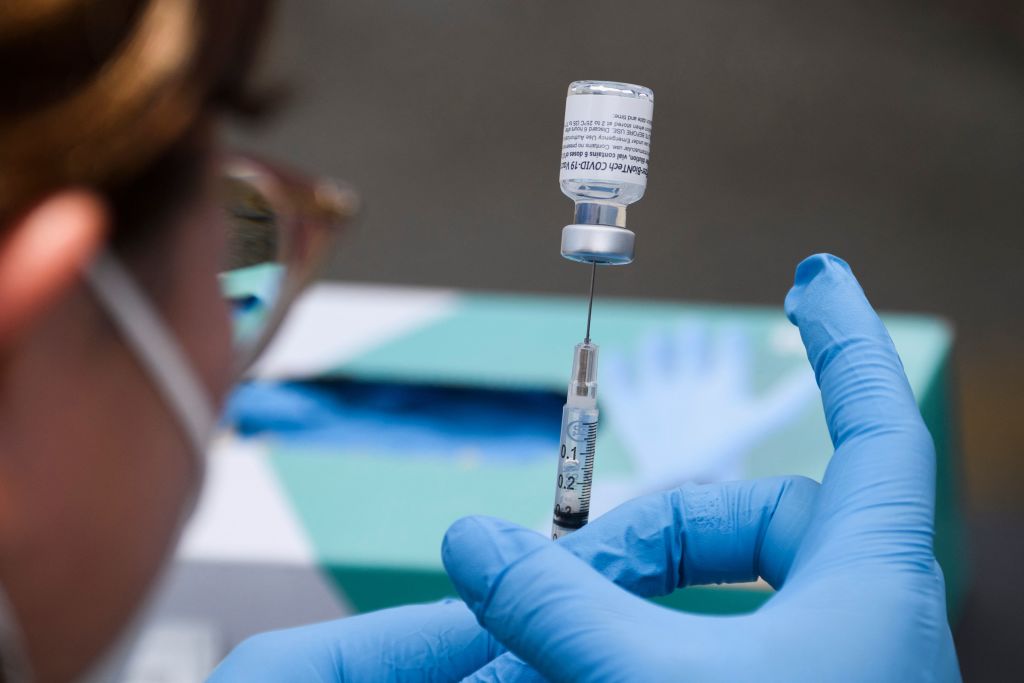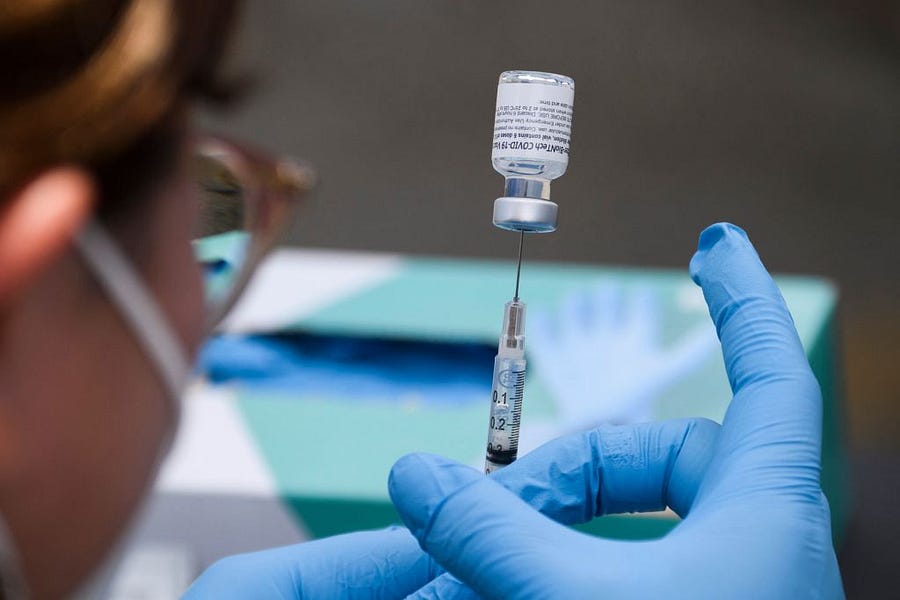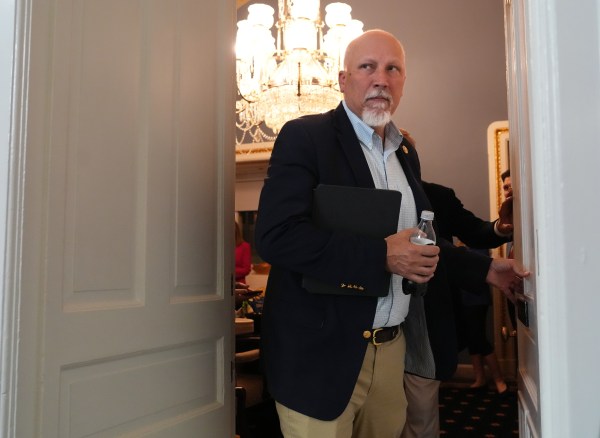Happy Tuesday! If you’re thinking about spending $200 on a fake COVID-19 vaccine card, we have a proposition for you: How about you get a real COVID-19 vaccine card for free, and then send two of your friends the gift of an annual Dispatch subscription instead?
-
A dramatically reduced risk of COVID-19 hospitalization or death ✅
-
More TMDers ✅
Quick Hits: Today’s Top Stories
-
Senate Democrats on Monday unveiled the full text of their $3.5 trillion budget resolution, creating a framework through which they will attempt to extend the child care tax credit, establish universal pre-K and community college, create a pathway to citizenship for certain illegal immigrants, and much more. Democrats will attempt to use the reconciliation process to pass the package, limiting the types of provisions that can be included but allowing them to advance the legislation with just 50 votes. The resolution does not include language on raising the debt ceiling, setting up a partisan squabble in the coming weeks as the Treasury Department’s ability to borrow runs out.
-
The U.S. military will in the coming weeks add the COVID vaccine to the long list of inoculations required of service members, per a memo from Defense Secretary Lloyd Austin. The move will take effect by September 15, and earlier if the vaccines receive full FDA approval before then. In a statement, President Biden said he “strongly supports” the move.
-
The United States, Canada, and United Kingdom imposed additional sanctions on Belarus on Monday, the one-year anniversary of what the Biden administration deemed the country’s “fraudulent” presidential election that reinstalled Belarusian strongman Aleksandr Lukashenko. The White House cited Lukashenko’s “elimination of political opposition and civil society organizations and the regime’s disruption and endangering of international civil air travel” as reasons for the additional sanctions.
-
In order to make room for an influx of COVID hospitalizations, Texas Gov. Greg Abbott on Monday asked hospitals in the state to “voluntarily postpone medical procedures for which delay will not result in loss of life or a deterioration in the patient’s condition.”
Why Kids Are Waiting for COVID Vaccine Approval

Whether it’s because of the rise of the Delta variant or increasingly prevalent mandates from employers or businesses, the pace of U.S. COVID-19 vaccination is on the rise once again after months of steady decline.
Three weeks ago, an average of 566,000 shots were being administered every day. Two weeks ago it was 673,000, and last week it was nearly 716,000. More than 80 percent of American senior citizens are now fully vaccinated against the virus, and the same can be said of 61 percent of U.S. adults. But among the American population as a whole, just a smidge over half are two weeks past their final dose. How is this possible? Tens of millions of kids remain ineligible for the shot.
A few weeks ago, we wrote about the Food and Drug Administration’s slow implementation of full COVID vaccine approval; it’s becoming increasingly clear the agency is doing the same thing when it comes to granting the shots emergency use authorization for children ages 5 to 11. As the Delta variant rages and the school year looms, concerned parents have received little guidance on how to keep their children safe—aside from updated CDC guidance recommending universal masking for everyone over the age of 2.
Asked in his CNN town hall last month when children under 12 might be able to be vaccinated, President Biden simply said “soon.” About that same time, an anonymous FDA official told NBC News that an EUA for this age group could be expected “midwinter.”
If anyone would have any insight into the timing, it’d be Dr. Paul Offit, director of the Vaccine Education Center at the Children’s Hospital of Philadelphia and a member of the FDA’s vaccine advisory committee. But he didn’t. “I can make this very easy for you,” he told The Dispatch yesterday with a laugh. “I don’t know any more than you do.”
The FDA authorized Pfizer-BioNTech’s vaccine for 12- to 15-year-olds in May, and Pfizer/BioNTech—as well as Moderna—began Phase II/III clinical trials for children under 12 in March. But regulators reached out to those pharmaceutical companies late last month requesting they expand the size of those trials—a process that will slow down final approval—in an effort to suss out any potential side effects, including the rare heart inflammation (myocarditis) issue that was slightly more prevalent in adolescents than adults.
Offit isn’t too worried. “There hasn’t really been a safety issue for vaccines in the last 200 years that occurred more than six weeks after any dose,” he said. “So I think the safety profile would be what it’s been before.” As such, he believes there “certainly should be” a sense of urgency on the FDA’s part to get the pediatric vaccine into arms—particularly given the new uncertainties surrounding the Delta variant.
“I do think [Delta is] clearly more contagious,” Offit continued. “It’s not quite clear to me that it is more likely to cause severe disease because it’s hard to separate those two things out. Obviously, there’s going to be more children who have serious disease for any virus that’s more likely to infect them.” Children are making up an increasingly large portion of new COVID cases in the United States, but those cases very rarely develop into something severe. Of the nearly 620,000 American deaths attributed to COVID, approximately 400—less than 0.1 percent—were children.
Regardless, Offit is far from the only one getting antsy. “We’re hearing from the ground from our pediatricians who are seeing patients in their practices and in their hospitals, that they are seeing a lot of very sick kids,” Dr. Lee Savio Beers—president of the American Academy of Pediatrics (AAP)—said earlier this month. The AAP—an association of nearly 70,000 pediatricians nationwide—sent a letter to acting FDA director Dr. Janet Woodcock on August 5 urging the agency to move quickly in authorizing the vaccines for pediatric use.
“We understand that the FDA has recently worked with Pfizer and Moderna to double the number of children ages 5-11 years included in clinical trials of their COVID-19 vaccines,” Beers wrote. “In our view, the rise of the Delta variant changes the risk-benefit analysis for authorizing vaccines in children. The FDA should strongly consider authorizing these vaccines for children ages 5-11 years based on data from the initial enrolled cohort, which are already available, while continuing to follow safety data from the expanded cohort in the post-market setting. This approach would not slow down the time to authorization of these critically needed vaccines in the 5–11-year age group.”
That kind of thinking, however, cuts deeply against how most government agencies—and the FDA in particular—have operated for years.
The FDA—Brown University School of Public Health Dean Ashish Jha told the New York Times recently—is designed to “mitigate the downside risk of drugs and vaccines. They are almost never asked to consider the downsides of delay.”
“That approach works, except if you’re in a global pandemic.”
A Global Problem That Demands Global Action
More than 200 U.N.-appointed climatologists released their periodic findings on the progression of climate change Monday, setting off a cascade of headlines—“Code red for humanity,” “Nothing but bad news,” “IPCC report’s verdict on climate crimes of humanity: guilty as hell”—signaling that the end is nigh and industrialized society is to blame.
The Intergovernmental Panel on Climate Change (IPCC) report predicted that the world would fall short of its goal to prevent human-induced global warming from rising 2.7 degrees Fahrenheit by the year 2100—and by a lot. If global emissions continue to accelerate at their current rate, the authors posit, warming will reach that benchmark within the next two decades.
Fortunately for humanity—if not clickworthy headlines—the report didn’t include much else beyond what climate scientists have already signaled. That is: Climate change is real, much of it is “unequivocally” human-inflicted, but it’s also reversible if the global community takes decisive and collective action.
Reducing the greenhouse gas concentration in the atmosphere—by limiting future emissions and taking steps to remove the carbon dioxide that’s already there—can achieve some of the long-term stabilization goals articulated in the findings.
“The IPCC has said before, and it’s confirmed in this report, that we can’t take different tools off the table. It’s an all hands on deck situation, which means we need to be using nuclear energy, carbon capture, natural climate solutions, a whole host of things,” Quill Robinson, vice president of government affairs at the American Conservation Coalition, told The Dispatch. “What we’re focused on is advocating for a diversity of policies that will help us reduce carbon emissions and sequester carbon from the atmosphere.”
“The issue isn’t new attention for the problem, but the lack of attention around solutions,” Arkansas GOP Rep. Bruce Westerman, ranking member of the Committee on Natural Resources, told The Dispatch. “We are letting our forests burn up year after year, relying on other countries with poor environmental and labor standards for critical minerals, and not effectively harnessing natural climate solutions on our public lands like innovative grazing.”
Westerman has long advocated for creative problem solving when it comes to climate change, including the development of renewable energy sources and implementation of natural carbon capture solutions. Last year, Westerman—the only forester in Congress—introduced legislation to plant 1 trillion trees globally by 2050, a simple yet effective way to remove harmful greenhouse gases from the atmosphere.
“Trees are the most effective carbon sequestration tool we have. Planting 1 trillion new trees globally could sequester 205 gigatons of carbon, equivalent to roughly two-thirds of man-made emissions remaining in the atmosphere since the Industrial Revolution,” Westerman said. “If we want to combat the climate crisis, we must acknowledge the important role that natural climate solutions, such as reforestation and active forest management, play in the solution.”
The IPCC report also drew a clearer line between human influence and natural disasters already upon us, like flooding, drought, wildfires, and heatwaves. Some adherents of attribution science—a term coined to describe the connection between the changing climate and weather—posit that if these events are caused by human activities, they can also be prevented by changes in those activities.
But because climate change is a global problem, it demands global action. And many analysts have criticized past efforts to limit global emissions, like the Paris Climate Agreement, as lacking any real enforcement mechanisms.
“My biggest issue with the Paris Climate Agreement was that it was more performative than substantive. I would like to see far more targeted ambitions that are easier to hold folks to account for,” GOP Rep. Peter Meijer of Michigan told The Dispatch. “We can control—to some degree—our own carbon output and other emissions output, but you have to acknowledge the leading role that India and China are playing, and how those projections are only accelerating.”
Robinson concurred, adding that trying to develop a robust climate strategy without first identifying the major drivers of global pollution is futile. “The fact is that the United States represents about 14 percent of global greenhouse gas emissions, whereas China is somewhere between 20 to 30 percent,” Robinson said. “I think people are realizing that we really need to hold China to account because their emissions are going up, while ours are leveling off and going down.” Environmental Protection Agency data from 2019 shows that, although U.S. greenhouse gas emissions have increased about 2 percent since 1990—despite a 31 percent increase in population over that time horizon—they are actually down 12 percent from 2005.
Developing domestic strategies to move away from fossil fuels and exporting them worldwide is also necessary to combat Beijing’s influence, Robinson argues, to prevent initiatives that prey on developing markets through coal-based infrastructure projects.
“As the world leader, our biggest concern should be countries like China with poor environmental records who must carry their weight in carbon reductions,” Westerman said. “Even if the U.S. cut all our carbon emissions tomorrow, we still wouldn’t achieve the climate reductions proposed by the recent report. We must hold other countries accountable.”
Worth Your Time
-
This remembrance of Bobby McIlvaine—from Jennifer Senior in The Atlantic—is outstanding. Bobby was 26 and working at Merrill Lynch when he died in the 9/11 attacks alongside thousands of others; Senior—whose younger brother was Bobby’s roommate—tells the story of his family’s mourning. “Early on, the McIlvaines spoke to a therapist who warned them that each member of their family would grieve differently. Imagine that you’re all at the top of a mountain, she told them, but you all have broken bones, so you can’t help each other. You each have to find your own way down,” she writes. “It was a helpful metaphor, one that may have saved the McIlvaines’ marriage. But when I mentioned it to Roxane Cohen Silver, a psychology professor at UC Irvine who’s spent a lifetime studying the effects of sudden, traumatic loss, she immediately spotted a problem with it: ‘That suggests everyone will make it down,’ she told me. ‘Some people never get down the mountain at all.’”
-
We wrote a few weeks back about the redistricting process playing out in states ahead of the 2022 midterms, and how it was being affected by the pandemic-induced delays to the 2020 Census. Nathaniel Rakich and FiveThirtyEight’s graphic design team debuted an incredible new tool this week that will be updated regularly to track the status of each state’s proposed congressional maps and which party is likely to benefit from them. “It’s hard to overstate the impact that redistricting will have over American politics for the next 10 years,” Rakich writes. “It is very important to track how the partisan makeup and competitiveness of districts in the congressional maps that get drawn this fall, winter and spring change—which is exactly what we’re doing at FiveThirtyEight. … You can look up which party controls redistricting in each state, where the process currently stands and when to expect a new map to take effect; for states with proposed or final maps, you can also view the demographic and partisan breakdown of the new districts, see which party gained or lost ground and check if the map exhibits any signs of gerrymandering.”
Presented Without Comment
Also Presented Without Comment
Also Also Presented Without Comment
Toeing the Company Line
-
David and Sarah are joined on today’s Advisory Opinions by Jonathan Rauch, author of The Constitution of Knowledge, for a wide-ranging discussion about the state of free speech and how big a threat illiberalism poses.
-
On the website today, Price St. Clair looks into whether our inequality and polarization are pushing the Republican Party into a form of “plutocratic populism.”
-
The conventional wisdom on kids and the internet has parents restricting screen time and confiscating phones. Stefanie Sanford reviews a new book that explores how to integrate technology and social media into their lives in ways that are useful and productive.
Let Us Know
With no vaccines for kids under 12 and lessons starting as early as this week in some states, it’s clear that the pandemic is going to affect at least part of a third school year. What is your local school district’s policy going to look like? All in-person learning or hybrid? Masks for everyone, masks for no one, or something in between?
Reporting by Declan Garvey (@declanpgarvey), Andrew Egger (@EggerDC), Charlotte Lawson (@charlotteUVA), Ryan Brown (@RyanP_Brown), Harvest Prude (@HarvestPrude), and Steve Hayes (@stephenfhayes).







Please note that we at The Dispatch hold ourselves, our work, and our commenters to a higher standard than other places on the internet. We welcome comments that foster genuine debate or discussion—including comments critical of us or our work—but responses that include ad hominem attacks on fellow Dispatch members or are intended to stoke fear and anger may be moderated.
With your membership, you only have the ability to comment on The Morning Dispatch articles. Consider upgrading to join the conversation everywhere.